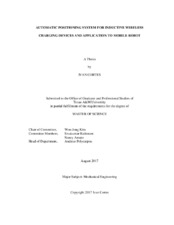| dc.description.abstract | Inductive power transfer (IPT) remains one of the most common ways to achieve wireless power transfer (WPT), operating on the same electromagnetic principle as electrical transformers but with an air core. IPT has recently been implemented in wireless charging of consumer products such as smartphones and electric vehicles. However, one major challenge with using IPT remains ensuring precise alignment between the transmitting and receiving coils so that maximum power transfer can take place. In literature, much of the focus is on improving the electrical circuits or IPT coil geometries to allow a greater transmission range. Nevertheless, most IPT products today rely on precise alignment for efficient power transfer.
In this thesis, the use of sensing coils to detect and correct lateral misalignments in a typical IPT system is modeled and tested. The sensing coils exploit magnetic-field symmetry to give a nonlinear measure of misalignment direction and magnitude. To test this idea, three experiments are performed: 1) measure the voltage of experimental sensing coils for various lateral misalignment distances, 2) implement closed-loop control and measure performance for an experimental two-dimensional (2D) automatic IPT alignment mechanism, and 3) test automatic IPT alignment on a plausible mobile robot wireless charging scenario. The experimental sensing coils give a misalignment sensing resolution of 1 mm or less in two lateral directions, allowing automatic alignment control in real time with a maximum lateral positioning error of less than √2 mm. This precise alignment allows for efficient power transfer to occur. When implemented on the mobile robot platform, the automatic positioning system gives similar results, allowing the robot to position itself above a wireless charger precisely—a task the mobile robot cannot accomplish using its navigation camera alone. The results of this experiment give confidence that similar sensing coils can be used to reduce lateral misalignments in scaled IPT systems, such as electric-vehicle wireless chargers. | en |


